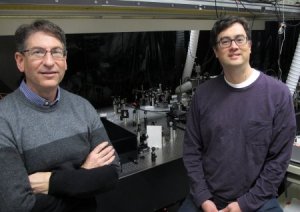Dec 22 2014
Researchers from the University of Oregon (UO) have conducted a spectroscopy experiment by illuminating four laser light pulses on nanoparticle photocells. This new research, which has been published in the Nature Communications journal, has provided an insight into the mechanism of converting captured sunlight into electricity.
 Andrew H. Marcus and Mark C. Lonergan stand by UO spectroscopy equipment
Andrew H. Marcus and Mark C. Lonergan stand by UO spectroscopy equipment
The research was carried out on photocells with lead-sulfide quantum dots that act as photoactive semiconductor material. The findings could help solar energy conversion devices improve their efficiency.
During the experiment, the researchers studied the development of excitons, multiple energy packets potentially generated by the absorption of each single sunlight particle or photon. These energy packets are capable of creating a number of free electrons, which induce electricity generation by a mechanism known as multiple exciton generation (MEG). Each absorbed photon, in most of the cases, produces one potential free electron.
Multiple exciton generation paves way for the development of solar cells that are more efficient and capable of generating electric current. This work reveals the new aspects of less-known MEG mechanism in nanomaterials.
UO professor Andrew H. Marcus stated that although the significance of MEG in the conversion of solar energy is still unclear, this experiment performed in association with Lund University scientists proved helpful in understanding other potential mechanisms in photovoltaic nanomaterials. The team used the Marcus’ spectroscopic experiments to carry out the measurement of photocurrent.
"Spectroscopy is all about light and molecules and what they do together," Marcus said. "It is a really great probe that helps to tell us about the reaction pathway that connects the beginning of a chemical or physical process to its end.
"The approach is similar to looking at how molecules come together in DNA, but instead we looked at interactions within semiconductor materials," said Marcus who is also an affiliate in UO's Institute of Molecular Biology, Materials Science Institute and Oregon Center for Optics. "Our method made it possible to look at electronic pathways involved in creating multiple excitons. The existence of this phenomenon had only been inferred through indirect evidence. We believe we have seen the initial steps that lead to MEG-mediated photo conductivity."
The work involved controlled sequencing of laser pulses which enabled the researchers to study the entrance of light, the interaction mechanism of light with the resting electrons, and its conversion into multiple excitons, in femtoseconds. Marcus stated that the combination of fluorescence two-dimensional spectroscopy and photocurrent provided details of the reaction mechanism.
Mark C. Lonergan, professor of physical and materials chemistry in UO, who studied the electrochemical and electrical processes in solid-state systems, co-related the processes taking place to a corn maze with three exits and one entrance through which people move. The people entering the corn maze signify photons in general, while the ones who exit the maze quickly signify the absorbed photons, which produce unwanted heat, The people exiting via the second exit represent the absorbed photons generating fluorescence but unusable free electrons. The people leaving via the third exit represent usable electric current.
"The question we are interested in is exactly what does the maze look like," Lonergan said. "The problem is we don't have good techniques to look inside the maze to discover the possible pathways through it. The techniques that Andy has developed basically allow us to see into the maze by encoding what is coming out of the system in terms of exactly what is going in. We can visualize what is going on, whether two people coming into the maze shook hands at some point and details about the pathway that led them to come out the electricity exit."
The project was initiated when Lund University's Tonu Pullerits reached Marcus to use his spectroscopy for studying ultra-fast photochemistry in semiconductor molecular materials. Following this, a postdoctoral researcher Khadga J. Karki working in Pullerits’ lab approached the UO and joined with Lonergan and Marcus group to redesign the equipment.
Julia R. Widom, UO doctoral student, Lund University's Joachim Seibt and UO graduate student Ian Moody are the co-authors of this study in addition to Lonergan, Marcus and Pullerits.